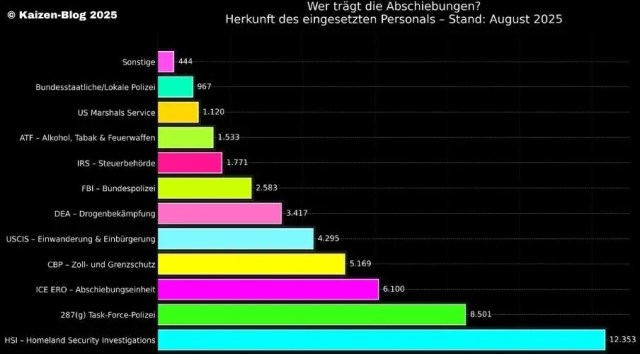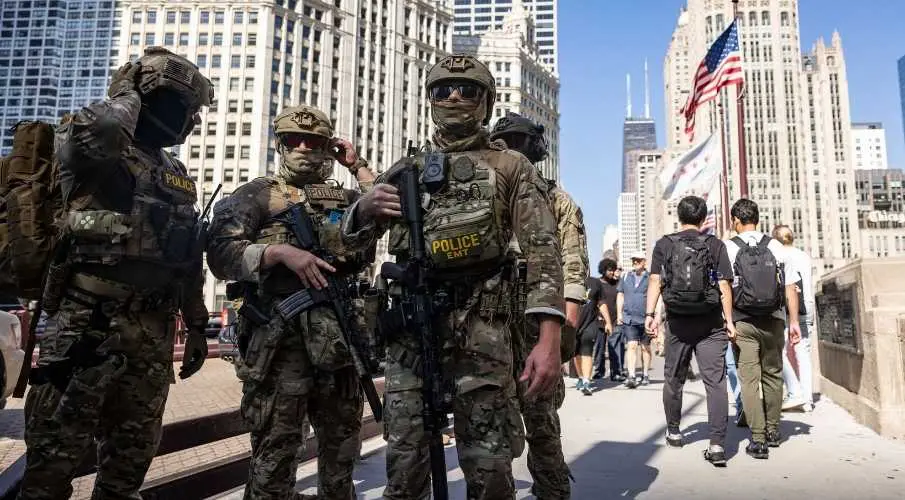The narrative is simple: more personnel, tougher crackdowns, more safety. The reality behind it is more complicated - and more dangerous. Our analysis of internal ICE figures, agency responses to inquiries, and publicly available datasets shows: Trump’s deportation machine is growing - and it is growing primarily by pulling investigators from other agencies. ICE does not bear the bulk of the load, but rather a patchwork of federal and state officers who were originally responsible for counterterrorism, weapons trafficking, organized crime, and homicide investigations. The core of the apparatus is ICE’s Enforcement and Removal Operations, or ERO. According to agency figures, ERO has just over 6,100 deportation officers of its own. But the decisive point sits one level lower in the tables: this summer, ERO was supported by around 42,000 personnel who do not belong to ERO - roughly 28,000 from federal agencies and over 13,000 from states and municipalities. In other words: only about 13 percent of the personnel implementing Trump’s deportation agenda on the street are actually employed by ERO. The rest are pulled from other tasks - primarily from classic crime fighting.

This has consequences that cannot be drowned out by PR slogans. In several federal agencies, teams were reassigned “temporarily” to ERO deployments, sometimes by email order, sometimes as longer details. Particularly striking is the scale: at the Bureau of Alcohol, Tobacco, Firearms and Explosives (ATF) alone, around 1,500 employees were reported in mid-summer as supporting ERO - a deep cut into the capacity of an agency that is supposed to work weapons smuggling and series of firearms crimes. In parallel, ICE reported more than 12,000 support personnel from the investigative directorate Homeland Security Investigations (HSI) - a number that even exceeds HSI’s publicly listed total workforce. We received no substantive clarification to our inquiries about the discrepancies.
What looks like efficiency on paper produces investigative breaks in practice. Specialists were pulled from FBI offices who normally handle terrorism, counterintelligence, and large-scale cybercrime. After an attack in early summer, some of these personnel were quietly sent back to their core assignments - an implicit admission that the repurposing had weakened national security. Anyone who says “security” and redirects investigators from terror and gun cases to civil deportations is building a theater, not a bulwark.
The diversion does not end at the federal level. ERO recruits “temporarily” from sheriffs’ departments and city police forces - often with wage reimbursement and bonus mechanisms when municipalities achieve particularly high rates with targets that ICE has “tipped” them to. These structures plug into two levers that are already established: first, into “Secure Communities,” which automatically matches every fingerprint taken in local stations against DHS databases and thus triggers ICE leads. Second, into 287(g) partnerships under the Immigration and Nationality Act, in whose “jail model” jail staff prepare notices and transfers on ICE’s behalf. Both shift municipal resources toward civil law - and away from homicide, rape, and aggravated assault.
That this blending disrupts actual law enforcement is not just theory. As early as 2018, senior HSI agents warned in a letter to DHS leadership that close linkage with ERO deportations undermined undercover investigations, destroyed source relationships, and endangered success in cases of child exploitation, drug trafficking, and human trafficking. The structural problem has not shrunk with the current wave of details, but grown. In addition, ICE “detainers” remain civil requests - not warrants. Multiple court decisions have already told municipalities that holding people solely on the basis of a detainer without a judicial order is constitutionally precarious. For police chiefs, that means a legal dilemma: either they tie up personnel in a federal agenda that makes them legally vulnerable on the ground, or they risk political pressure and loss of funding.
The balance sheet of this shift is as sober as it is sobering. On paper, deportation forces grow. In the precincts, the backlog grows as well: open case series, postponed crime scene analyses, abandoned casework. Where investigators rotate through staging sites and fugitive teams, they are missing from evidence processing, witness work, and case building. And where deportation becomes the headline, law enforcement becomes the footnote. The government sells this as prioritization. In truth, it is a swap of priorities. Anyone who pulls 42,000 personnel nationwide from their core work to accelerate a civil agenda deprives crime fighting of oxygen. Anyone who removes ATF investigators from gun cases, HSI specialists from child exploitation cases, and FBI analysts from terror threats does not create safety - they create gaps.
What remains is the simple question that every city, every sheriff, and every federal office must answer: what is not getting done in the time we are running deportations? Which firearm is not traced, which offender group not identified, which crime scene not processed? Safety is not measured by the number of buses rolling to staging sites, but by the number of crimes we prevent and solve. As long as political marketing confuses “toughness” with “safety,” this shift will continue. Our task as journalists is to translate the numbers into reality: whom are they pulling off, for what - and what does it cost where crime actually happens. The result is already visible today. It is a republic that pulls its investigators out of the engine room to move scenery - and that will pay a price no press conference can conceal.
Investigative journalism requires courage, conviction – and your support.
Please also strengthen our journalistic fight against right-wing populism and human rights violations. We do not want to finance ourselves through a paywall so that everyone can read our research – regardless of income or origin. Thank you very much!


Die Frage, die ich mir immer stelle ist:
Es sind Landesbeamte. Also Angestellte der Bundesstaaten.
Das rote Staaten da begeistert mit machen und sich gegenseitig im Erfolg übertreffen wollen, ist mir klar.
Aber was ist mit den in blauen Staaten? Warum sind die da auch so willfähig?
Besteht die Bevölkerung zur Mehrheit nur noch aus rassistischen Idioten?
Gewaltdelikte…. uninteressant, im Zweifel kommt die Nationalgarde und regelt das.
Drogendelikte, da zerbombt man lieber einfach Boote und tötet ohne jegliche Legitimation Menschen.
Vergewaltigung? Das ist eine Erfindung der Frauen und das gibt es nicht wirklich. Und wenn doch, dann war es Schuld der Frau, weil sie es provoziert hat.
Hauptsache es werden Menschen einfach aus ihren Autos gezerrt, verhaftet und ins Detention Center gebracht. Egal das viele Verhaftungen US-Staatsbürger treffen.
Hauptsache MAGA kann Verhaftungen und Abschiebungen feiern…. „that’s what I’m voting for“ 🤮
👍